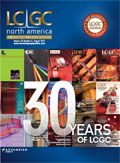LCGC and Its Readers: 30 Years Strong
LCGC North America
LCGC's global online presence is an ever-growing aspect of this publication as we strive to bring our readers the knowledge they need in a timely manner.
LCGC's global online presence is an ever-growing aspect of this publication as we strive to bring our readers the knowledge they need in a timely manner.
In a way, you could say that LCGC has been married to its readers for the past 30 years. During this time, the bond shared by LCGC and our readers has remained strong, centered in a shared passion for excellence in separation science. In a marriage, the traditional gift for a 30th anniversary is a pearl. In a nontraditional interpretation of that marriage rite, I think this issue of LCGC presents a "pearl of wisdom" for our readers as we look back on how the techniques, technology, and applications have changed throughout the history of this publication as well as some insight as to what the future may hold.
In the beginning, LCGC was known only as LC, keeping that moniker until its fourth volume, when the name LCGC was introduced. We started strong with columns and articles written by some of the most influential scientists in the field: Tom Jupille, Ron Majors, Fred Rabel, and John Dolan, just to name a few. We have continued that trend over the years, understanding that our readers trust and value the opinions of the leaders in separation science. As technology expanded, we grew our business to include interactive webcasts featuring some of the very same scientists our readers turn to for help. Through these webcasts, our audience is able to interact live with experts and ask them questions in real-time — a step forward that no one would have imagined during the first days of LC.
However, LCGC's advancements don't stop at webcasts; in the last decade we started offering our readers weekly newsletters highlighting the latest trends, articles, application notes, and news. Additionally, our website is now global, combining LCGC North America, LCGC Europe, and LCGC Asia as well as CHROMacademy, our troubleshooting, e-learning, and professional development platform. LCGC's global online presence is an ever-growing aspect of this publication as we strive to bring our readers the knowledge they need in a timely manner.
LCGC is not the only one celebrating this year: I also am commemorating my 20th year with the magazine. I have seen a lot of positive change over the years and can say without a doubt that throughout LCGC's storied history, we have always strived to keep our readers informed. None of that would have been possible without the help of our excellent staff, columnists, and writers from around the globe — we are truly indebted to you all. Finally, we cannot forget to thank our valuable readers, without whom this "marriage" would not exist: Thank you all, and enjoy your pearl!
Happy 30th Anniversary, LCGC!
Michael J. Tessalone
Science Group Publisher

Michael J. Tessalone

A Novel LC–QTOF-MS DIA Method for Pesticide Quantification and Screening in Agricultural Waters
May 8th 2025Scientists from the University of Santiago de Compostela developed a liquid chromatography quadrupole time-of-flight mass spectrometry (LC–QTOF-MS) operated in data-independent acquisition (DIA) mode for pesticide quantification in agriculturally impacted waters.
Investigating 3D-Printable Stationary Phases in Liquid Chromatography
May 7th 20253D printing technology has potential in chromatography, but a major challenge is developing materials with both high porosity and robust mechanical properties. Recently, scientists compared the separation performances of eight different 3D printable stationary phases.

.png&w=3840&q=75)

.png&w=3840&q=75)



.png&w=3840&q=75)



.png&w=3840&q=75)














